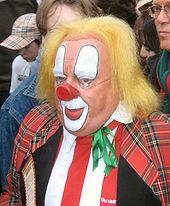Cardboard nose

The cardboard nose (also known as the clown nose ) is a worldwide known disguise tool for jokers and clowns , especially during carnival . It is put over the nose and in this way overdraws the head profile or facial features. The classic cardboard nose is made of paper mache , dyed red and is attached with a rubber band behind the ears or on the fool's cap . Modern cardboard noses are made of plastic and foam . But there are also cardboard noses made of wood, metal or leather; and sometimes they are not red, but green, blue, gold, or silver.
In addition, the term cardboard nose is also used in common parlance as a loving satirization of people with obvious or suspected inadequacies ("you cardboard nose").
The motto of the 2006 Cologne Carnival was: Habemus Pappnas . It was derived from " Habemus Papam ", alluding to Joseph Ratzinger's election as Pope , and in the "Pappnas" it also illustrated the carnival's ability to freely criticize religion . On various occasions, however, it also met with criticism that the Cologne junkies described the newly elected Pope as a cardboard nose.
A special form of the cardboard nose is presented in the film Ödipussi by Loriot : A member of the “Association for the Integration of the Concepts of Environment and Carnival in Women” puts on a gray cardboard nose that is labeled with the terms “woman” and “environment”. Coming from the men's room of the club, this gentleman wears the cardboard nose on his forehead when he rebukes a bourgeois dressed youth with a punk hairstyle.
In the southern Baden region, the cardboard nose is also known as Flanny , in northern Baden as Flunny.
swell
- Hermann Ehmann: Endgeil: The fully correct lexicon of youth language . CH Beck 2009, ISBN 9783406573873 , p. 103 ( excerpt in the Google book search).
- "You pappnase, you!" ( Memento from March 7, 2011 in the Internet Archive ) - history of the Pappnase on WDR 5 on March 3, 2011.
